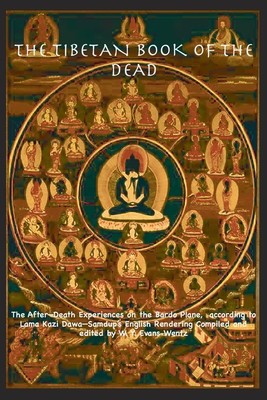
- We will send in 10–14 business days.
- Publisher: Ancient Wisdom Publications
- ISBN-10: 1963956869
- ISBN-13: 9781963956863
- Format: 15.2 x 22.9 x 1.6 cm, mīksti vāki
- Language: English
- SAVE -10% with code: EXTRA
THE TIBETAN BOOK OF THE DEAD OR The After-Death Experiences on the Bardo Plane, according to Lāma Kazi Dawa-Samdup's English Rendering (e-book) (used book) | bookbook.eu
Reviews
Description
The bar do thos grol has become known in the English speaking world as The Tibetan Book of the Dead, a title popularized by Walter Evans-Wentz's edition, after the Egyptian Book of the Dead, though the English title bears no relationship with the Tibetan's, as outlined above. The Evans-Wentz edition was first published in 1927 by Oxford University Press.
At age 24 Evans-Wentz went to Stanford University, where he studied religion, philosophy, and history and was deeply influenced by visitors William James and W. B. Yeats. He went on to receive B.A. and M.A degrees. He then studied Celtic mythology and folklore at Jesus College, Oxford (1907). He performed ethnographic fieldwork collecting fairy folklore in Wales, Scotland, Ireland, Cornwall, Brittany, and the Isle of Man. In 1911 Evans-Wentz published his degree thesis as a book, The Fairy-Faith in Celtic Countries. While at Oxford, he added his mother's Welsh surname Evans to his name, being known henceforth as Evans-Wentz.
Kazi Dawa Samdup's education began at the age of four learning the Tibetan script from his grandfather. In 1874 he joined the Bhutia Boarding School in Darjeeling where he impressed the headmaster Rai Bahadur Sarat Chandra Das. His Tibetan teacher was Ugyen Gyatso, a lama from the Pemayangtse monastery in West Sikkim.
- Publisher: Ancient Wisdom Publications
- ISBN-10: 1963956869
- ISBN-13: 9781963956863
- Format: 15.2 x 22.9 x 1.6 cm, mīksti vāki
- Language: English English
The bar do thos grol has become known in the English speaking world as The Tibetan Book of the Dead, a title popularized by Walter Evans-Wentz's edition, after the Egyptian Book of the Dead, though the English title bears no relationship with the Tibetan's, as outlined above. The Evans-Wentz edition was first published in 1927 by Oxford University Press.
At age 24 Evans-Wentz went to Stanford University, where he studied religion, philosophy, and history and was deeply influenced by visitors William James and W. B. Yeats. He went on to receive B.A. and M.A degrees. He then studied Celtic mythology and folklore at Jesus College, Oxford (1907). He performed ethnographic fieldwork collecting fairy folklore in Wales, Scotland, Ireland, Cornwall, Brittany, and the Isle of Man. In 1911 Evans-Wentz published his degree thesis as a book, The Fairy-Faith in Celtic Countries. While at Oxford, he added his mother's Welsh surname Evans to his name, being known henceforth as Evans-Wentz.
Kazi Dawa Samdup's education began at the age of four learning the Tibetan script from his grandfather. In 1874 he joined the Bhutia Boarding School in Darjeeling where he impressed the headmaster Rai Bahadur Sarat Chandra Das. His Tibetan teacher was Ugyen Gyatso, a lama from the Pemayangtse monastery in West Sikkim.


Reviews